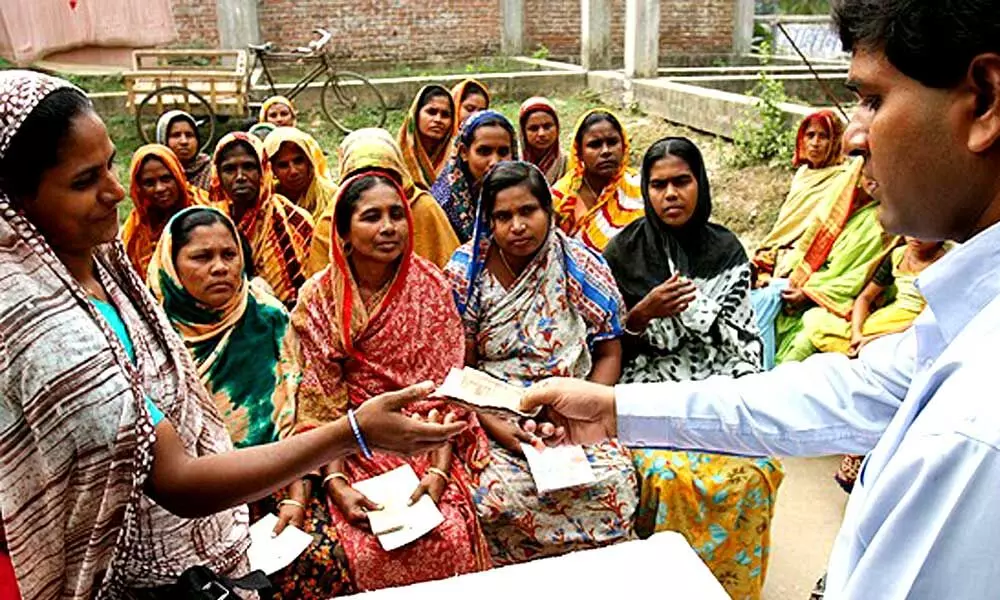Decline in customers leads to dip in microfinance AUM
MFI loans declined 7%, average exposure per borrower down 4% due to the impact of Covid-19
image for illustrative purpose

MFI industry loans stood at Rs 2.4 trillion, declining by 7% due to 70% decline in disbursements as well as by 2% decline in borrower base and higher write-offs during the quarter. Average borrower balance declined 4%, similar to the decline in active loan accounts
Mumbai: Microfinance AUM decreased by seven per cent quarter on quarter (q-o-q), led by two per cent decline in customers and 4 per cent decline in average exposure per customer in the first quarter of the current financial year as fallout of Covid-19, a study reveals. Still, the experts feel that the second quarter onwards things will improve on the front with the festive season on and several other factors.
Early delinquencies have shot up due to Covid 2.0, with lenders resorting to disbursing small-ticket loans as well as lending to higher vintage customers. Inferences from bureau data need some caution due to variances in reporting of restructuring/ deferment practices by lenders. Nonetheless, on-ground normalcy will support loan growth and provide room for absorbing credit costs, says a report by RBI approved credit bureau CRIF Highmark Credit Information Services Pvt Ltd.
Microfinance institutions (MFI) loans declined by 7 per cent q-o-q, average exposure per borrower is also down by 4 per cent on q-o-q basis. The report reflects the impact of Covid on all fronts. MFI industry loans stood at Rs 2.4 trillion, declining by 7 per cent q-o-q due to by 70 per cent q-o-q decline in disbursements as well as by 2 per cent decline in borrower base and higher write-offs during the quarter.
Average borrower balance declined 4 per cent q-o-q, similar to the decline in active loan accounts. Disbursements declined by 70 per cent q-o-q with lender-wise disbursements showing greater skew towards banks, a trend that has continued since the start of Covid, the report adds.
Talking to Bizz Buzz, Manoj Kumar Nambiar, MD, Arohan Financial Services and past chairman of MFI Network, an industry body of MFIs, says, "Yes, Q1 was difficult for the microfinance sector due to localized lockdowns across the country due to the second wave of Covid-19. It was due to the fact that collections were difficult from the perspective of both borrowers and the lender as well. But, let me add here that things are set to improve from Q2 onwards. You will come to know of it shortly when the MF companies declare their financial results for the Q2 within a fortnight's time."
Citing the reason, he said that first the festive season was on, post the opening up began since second half of June itself also the numbers in Q2 are significantly better. Collection efficiency has improved and livelihoods have opened up as we enter in the first month of the third quarter. We all hope that if the momentum continues, then Q3 and Q4 will definitely be much, much better than that of the Q1.
Average ticket size as well as exposure per borrower declined by 5 per cent each q-o-q to Rs 36,000 and Rs 40,000 respectively. At a portfolio level, share of less than Rs 40,000 ticket loans has increased to 50 per cent of AUM compared to 40 per cent at the start of pandemic.
Also, the AUM growth in recent quarters is notably higher in the low-ticket segments (rs 10,000)="" or="" the="" higher="" ticket="" segments="" (="">Rs 40,000). This could reflect comfort in giving top-up loans during times of pressure on collections and disbursements towards existing higher vintage borrowers. Proportion of borrowers associated with four or more lenders continues to be the highest in TN.
Analysts feel that this is only a rear-view mirror analysis of asset quality as bureau data needs to be viewed with some caution. Overdue loans expectedly increased with 1-30 days past due (dpd) at 19 per cent (from 5 per cent q-o-q) whereas 31-180 dpd book at 15 per cent (from 10 per cent q-o-q) and 180 plus is 7 per cent (from 4 per cent q-o-q). Lenders have seen a sharp flow forward into overdue loans due to the second Covid wave with signs of improvement towards end of June.
Banks have seen much lower q-o-q rise in 30 plus loans, compared to other lender types which corroborates with lower rise in 30+ loans and stronger loan growth as well in the higher ticket segment. States with recent elections (Assam, West Bengal, Tamil Nadu) exhibit the highest overdue loans.
There is one note of caution when reading the overdue loans. First, restructured loans are probably not fully captured yet and possibly sit outside the current overdue loans to some extent. Secondly, a few lenders had provided deferment of a few weeks along with a dpd freeze during April-May but it's unlikely that bureaus are able to correct these anomalies which may result in understating of overdue loans.
Collections have improved across players (albeit gradually for few), in recent months. High credit losses are inevitable given the bloated overdue book, however, kick-starting growth and new customer acquisition will provide P&L cushion to credit costs which are likely to continue for a few quarters. While regulatory overhang appears much lower post the draft harmonization guidelines, risks from State elections and potential waiver noises have increased post the Assam issue. Analysts prefer a more tactical approach while investing in MFI stocks/ theme.

